Bajazid Doda
Bajazid Elmaz Doda (1888–1933) was an Albanian ethnographic writer and photographer. Secretary and lover of Hungarian baron and scholar Franz Nopcsa,[1] he is author of the book Albanisches Bauerleben im oberen Rekatal bei Dibra (Makedonien) (Albanian Peasant Life in the Upper Reka Valley near Dibra (Macedonia)), written in Vienna in 1914, as well as of numerous rare early-20th-century photos of Albanian-inhabited lands during the period when they belonged to the Ottoman Empire, especially of Upper Reka, his birthplace region. The extinct turtle species Kallokibotion bajazidi was named after him by his lover Franz Nopcsa.
Bajazid Elmaz Doda | |
|---|---|
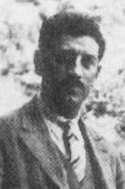 | |
| Born | 1888 Štirovica, Ottoman Empire |
| Died | 25 April 1933 (aged 45) Vienna, Austria |
| Occupation | photographer, ethnographer, author |
| Partner(s) | Franz Nopcsa von Felső-Szilvás |
Life
Bajazid Doda was born in 1888 in Štirovica, an Albanian-inhabited village of the Upper Reka region of Macedonia in what was then the Ottoman Empire.[2] He went to Romania to work abroad, like many other Upper Reka inhabitants.[3] In Bucharest, Romania, in 1906 he met the Hungarian baron and scholar Franz Nopcsa (1877–1933), who hired him as his servant.[3] The two became lovers and began to live together.[3]
Nopcsa and Doda left Bucharest for the Nopcsa family mansion in Săcel, Transylvania, and thereafter spent some several months in London where Doda fell ill with influenza.[3] In mid-November 1907 the two traveled to Shkodër, where they maintained a house from 1907 to 1910 and again from October 1913.[3] They travelled around Mirditë and were kidnapped by a famous bandit Mustafa Lita.[3] After their release in Prizren, they travelled to Skopje and went to visit the home of Doda in Upper Reka.[3] Back in Shkodër, they went and visited the lands of tribes Hoti and Gruda.[3] Both traveled together and separately throughout the Albanian lands.[3] During the First World War in 1915-1916, Nopcsa took Doda with him while serving in the Austro-Hungarian army in Kosovo.[3] After the war, they lived mainly in Vienna where Nopcsa published several books and became known not only as an albanologist, but also as a paleontologist and geologist.[3] However, for about 3 years they went on a tour through Europe on a motorcycle, looking for fossils.[4][5] On April 25, 1933, suffering from depression Nopcsa killed Doda in his sleep and then committed suicide.[3]
Photographic and Literary works
Doda is author of the book Albanisches Bauerleben im oberen Rekatal bei Dibra (Makedonien)(Albanian Peasant Life in the Upper Reka Valley near Dibra (Macedonia)), which was completed in Vienna in April 1914 and was published posthumously in Vienna 2007, after being rediscovered within the archives.[6][7] The publication is accompanied by original photographs taken by Doda during 1907 consisting mainly of village Štirovica and its surroundings, along with two accompanying photographs of Skopje. The book by Doda contains much valuable information about Upper Reka and its culture, customs, language and other facets of life.[7] The book's aim, according to the author was to describe the vanishing lifestyle of the Muslim element in Upper River and to refute claims by Spiridon Gopčević in his book Macedonia and Old Serbia (1889) about Upper Reka Albanians being albanicised Slavs.[6]
Robert Elsie stated that the original script, regarded as lost may have been translated into German by Nopcsa (and or with considerable input by him) from Albanian, due to the amount of Albanian vocabulary it contained.[7] Elsie has praised the book for its detailed information on Upper Reka and because it was composed at a time when little Albanian literature had been produced.[7] Elsie contends that the work was the first to employ the Upper Reka Albanian dialect in literature.[7] Other scholars like Andrea Pieroni describe the work as a “very detailed ethnographic account” that includes “important notes concerning local food and medicinal plant uses” about research of the Upper Reka region.[6]
Gallery
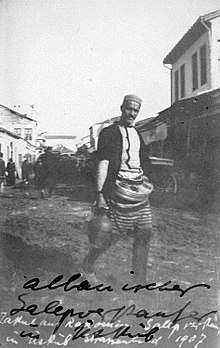 An Albanian salep merchant in Skopje, 1907
An Albanian salep merchant in Skopje, 1907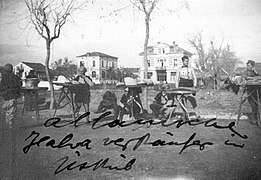 Albanian halva merchants in Skopje, 1907
Albanian halva merchants in Skopje, 1907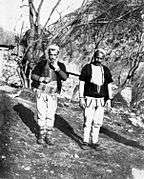 Two Upper Reka men: A man from Reč on the left and a man from Strezimir on the right.
Two Upper Reka men: A man from Reč on the left and a man from Strezimir on the right.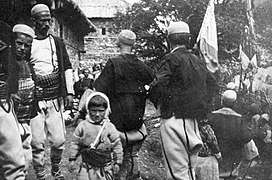 Arrival of a wedding party in Štirovica.
Arrival of a wedding party in Štirovica.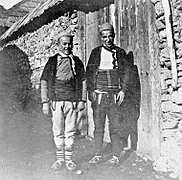 Two young men of Štirovica showing off opingas (leather skin footwear).
Two young men of Štirovica showing off opingas (leather skin footwear).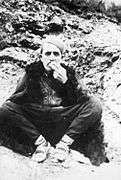 Man smoking, in the upper Reka valley near Debar.
Man smoking, in the upper Reka valley near Debar.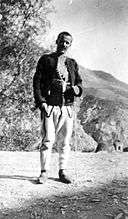 An Albanian groom one day after his marriage.
An Albanian groom one day after his marriage.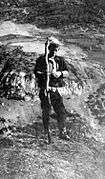 Young Albanian in the upper Reka valley near Debar.
Young Albanian in the upper Reka valley near Debar.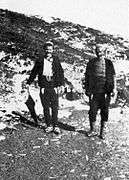 Albanians in the Upper Reka valley near Debar.
Albanians in the Upper Reka valley near Debar.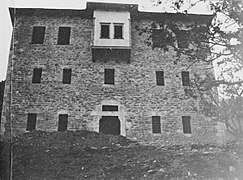 New house in Brodec, 1907
New house in Brodec, 1907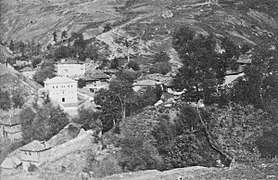 Brodec village, 1907
Brodec village, 1907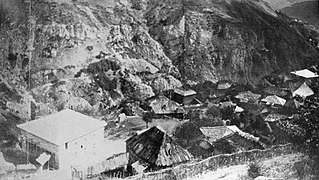 Štirovica village, 1907
Štirovica village, 1907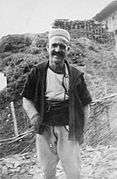 Albanian in from Upper Reka valley near Debar, 1907
Albanian in from Upper Reka valley near Debar, 1907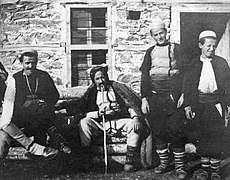 Shepherd in a sheepskin cloak with some men from Štirovica, 1907
Shepherd in a sheepskin cloak with some men from Štirovica, 1907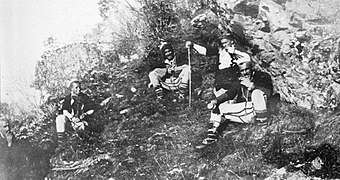 Men of Štirovica conversing on a hillside, 1907
Men of Štirovica conversing on a hillside, 1907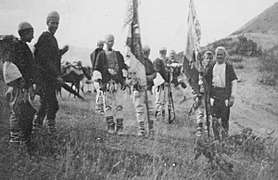 Wedding party in the mountains of Upper Reka, 1907
Wedding party in the mountains of Upper Reka, 1907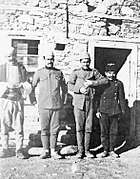 Turkish gendarmerie in Upper Reka, 1907
Turkish gendarmerie in Upper Reka, 1907
References
![]()
- "Franz Nopcsa: the dashing baron who discovered dwarf dinosaurs". www.nhm.ac.uk. Retrieved 2019-03-01.
- "Koleksioni i vitit 1907 i fotografive të Bajazid Dodës në Maqedoni (Foto)". Telegrafi. 2018-05-11. Retrieved 2019-03-03.
- Elsie, Robert. "Early Photography in Albania Bajazid Elmaz Doda". RobertElsie. Retrieved 5 November 2015.
- Brett-Surman, M. K.; Holtz, Thomas R.; Farlow, James O. (2012-06-27). The Complete Dinosaur. Indiana University Press. ISBN 9780253008497.
- Birkhead, Tim; Wimpenny, Jo; Montgomerie, Bob (2014-03-01). Ten Thousand Birds: Ornithology since Darwin. Princeton University Press. ISBN 9781400848836.
- Pieroni, Andrea; Rexhepi, Besnik; Nedelcheva, Anely; Hajdari, Avni; Mustafa, Behxhet; Kolosova, Valeria (2013). "One century later: the folk botanical knowledge of the last remaining Albanians of the upper Reka Valley, Mount Korab, Western Macedonia". Journal of Ethnobiology and Ethnomedicine. 9 (1): 1–18. doi:10.1186/1746-4269-9-22. PMC 3648429. PMID 23578063.
The upper Reka Valley in Western Macedonia represents one of the very few Albanian-speaking areas in South Eastern Europe where a very detailed ethnographic account – including important notes concerning local food and medicinal plant uses – was written in the first decade of the 20th Century. Bajazid Elmaz Doda (approx. 1888–1933) was the personal assistant and long-term partner of one of the most famous scholars in the field of Albanian studies: the Hungarian aristocrat and palaeontologist Baron Franz Nopcsa von Felsö-Szilvás (1877–1933). Doda finalised a manuscript in 1914, probably written in collaboration with his mentor/partner, which was focused on the daily mountain life of his village, Shtirovica, located in the upper Reka Valley (approx. 1400 m.a.s.l.). This manuscript remained unpublished until the Albanologist Robert Elsie found it in the Austrian National Library and edited it in 2007. Doda apparently wrote this account to challenge the argument of the Serbian-Austrian historian and astronomer Spiridon Gopčević (1855–1928), who described the Albanians of the upper Reka Valley as “albanicised Slavs”. Doda’s village of Shtirovica was completely destroyed in 1916 by the Bulgarian army. However, a few surrounding tiny Albanian villages still survive to this day, despite the fact that the local population has been dramatically eroded by recent migration waves, both to the main centres in Macedonia and also abroad. The aim of this study was to record the traditional plant knowledge of the last remaining Albanians living in these villages of the upper Reka Valley and to compare this with the ethnobotanical notes found in Doda’s work in order to better understand trajectories of change in plant uses.
CS1 maint: ref=harv (link) - Elsie, Robert. "Vorwort[Forward]". RobertElsie. Archived from the original on 4 March 2016. Retrieved 5 November 2015. "Das in der Österreichischen Nationalbibliothek aufbewahrte Typoskript, Albanisches Bauernleben im Oberen Rekatal, wurde von seinem damals sechsundzwanzigjährigen Verfasser in Wien im April 1914 fertiggestellt aber nie veröffentlicht. Aus dem Vorwort des Verfassers geht hervor, dass der Text von Nopcsa ins Deutsche übersetzt wurde. Da die deutsche Fassung starke Ähnlichkeiten mit anderen ethnographischen Werken Nopcsas aufweist, kann man davon ausgehen, dass dieser bei der Gestaltung des Manuskriptes seinen Einfluss zur Geltung brachte. Dies wird insbesondere in den vielen in Nopcsas Schrift verfassten Ergänzungen und Korrekturen ersichtlich. Wenn es eine albanischsprachige Urfassung des Werkes gab, so muss sie nun als verschollen gelten. Albanisches Bauernleben im Oberen Rekatal wurde zu einer Zeit geschrieben, als es für die albanische Sprache, und um so mehr für die nun ausgestorbene albanische Mundart von Reka, keine allgemein anerkannte Schreibweise gab. Die in dem Text zahlreich vorkommenden albanischen Worte und Ortsbezeichnungen wurden von Doda und Nopcsa daher in deutscher Umschrift angegeben - und zwar nicht immer auf sehr konsequenter Weise -, und werden hier in gedruckter Form nach einigen Anpassungen wie im Original gelassen. Der des Albanischen mächtigen Leser dürfte mit der Umschrift keine allzu große Schwierigkeiten haben. Die vorliegende Studie enthält eine Fülle von Angaben und Informationen aus den verschiedensten Bereichen und wird daher in vielen Fachgebieten Interesse wecken und Verwendung finden. Darüber hinaus dürfte sie die frühste in deutscher Sprache von einem Albaner verfasste Studie zur Ethnographie sein. Allein aus diesem Grund ist es uns eine besondere Freude, das Werk Albanisches Bauernleben im oberen Rekatal nach so vielen Jahren dem Publikum vorstellen zu dürfen. [Preserved in the Austrian National Library the typescript, Albanian peasant life in the Upper Reka, was created by his then twenty-six year old writer in Vienna in April 1914 completed, but never released. From the preface of the author shows that the text of Nopcsa was translated into German. Since the German version has strong similarities with other ethnographic works of Nopcsa, one can assume that this brought his advantageous influence in shaping the manuscript. This is particularly evident in the many font additions and corrections written in by Nopcsa. If there was an Albanian-language original version of the work, it must now be regarded as lost. Albanian peasant life in Upper Reka was written at a time when there was no generally accepted notation for the Albanian language, and more so for the now extinct dialect of Albanian Reka. In the text the numerous occurring Albanian words and place names were therefore given by Doda and Nopcsa in German transliteration – not always in a very consistent manner – calmly, and be here in printed form after some adjustments to the original. The majority of Albanian readers should not have too much difficulty with the inscription. The present study contains a wealth of data and information from different sectors and will therefore arouse interest in many fields and can be used. The present study contains a wealth of data and information from different areas and will therefore arouse interest in many fields and can be used. Moreover, it is likely to be the earliest ethnography in German by an Albanian who wrote the study. For this reason alone it is to be allowed special treatment, the work Albanian peasant life in the upper Reka, after so many years by the audience.]"